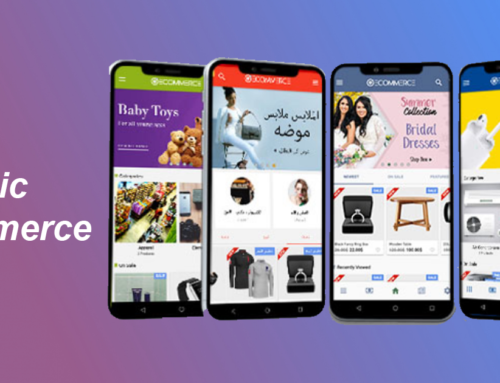Crafting robust WooCommerce apps with integrated backends becomes an exciting journey when utilizing the power of both ionic woocommerce app with a backend and flutter woocommerce apps with a backend. In the app development world, Ionic shines with its familiarity with web technologies like HTML, CSS, and JavaScript, making it a comfortable choice for developers who value a web-like approach across various platforms. On the other hand, Flutter adds its magic through widgets – small building blocks that come together like Lego pieces to create strikingly customizable and visually appealing user interfaces. So, whether you lean towards Ionic’s adaptable nature or Flutter’s widget wonderland, both frameworks offer a unique route to bring your eCommerce app dreams to life while ensuring a smooth backend integration.
Comparing Ionic and Flutter for WooCommerce Backend Apps
Embarking on the journey of developing WooCommerce backend apps opens up a world of possibilities where scalability and flexibility become guiding stars. Flutter woocommerce app with backend, with its roots in web technologies, promises scalability as it effortlessly extends your app’s presence across diverse platforms. Flexibility takes center stage too. As Ionic leverages familiar web skills, allowing developers to weave adaptable interfaces effortlessly. Meanwhile, the flutter woocommerce app with backend boasts scalability through its widget-powered architecture, ensuring harmonious growth of app components. Flexibility dances alongside, Flutter’s vast widgets empowering developers to craft unique, intricate designs.
Backend Configuration for Ionic App
Configuring the backend for your WooCommerce app built with Ionic is like setting up the engine for a seamless journey. It involves creating a sturdy bridge between your app and the WooCommerce platform. With an ionic woocommerce app with backend, this process becomes a breeze due to its knack for integrating well with various backend technologies. Ionic’s flexibility allows you to establish a secure connection. This connection acts as a conduit for fetching product data, managing user authentication, and handling orders efficiently. By configuring the backend meticulously, you ensure that your Ionic WooCommerce app functions smoothly and syncs harmoniously with the WooCommerce ecosystem.
Backend Configuration for Flutter App
The backend configuration for your WooCommerce app built with Flutter is like setting up the backstage gears for a captivating performance. Flutter woocommerce app with backend, known for its versatility, provides developers the canvas to link their app with the WooCommerce platform seamlessly. This process involves creating a robust bridge between your app’s front end and the WooCommerce backend, ensuring a secure and efficient data exchange. Integrating APIs and endpoints enables your Flutter app to fetch product information, manage user authentication, and handle transactions flawlessly. Mastering this backend setup paves the way for a dynamic eCommerce experience, where Flutter’s magic harmonizes with WooCommerce’s capabilities, all behind the scenes.
The Rawal Approach for Woocommerce App
Designing a fluid backend API for user data within your WooCommerce app, using the “Rawal Approach” is all about ensuring a smooth and efficient connection between your app and its data source. With this method, developers craft a robust API that seamlessly interacts with WooCommerce, simplifying fetching and updating user-related information. Following the Rawal Approach empowers your app to manage user profiles, purchase history, and preferences securely. This translates to an enhanced user experience, as your WooCommerce app effortlessly communicates with the backend, making data retrieval and updates a breeze.
Integrating Payment Gateways for Secure Transactions
Incorporating payment gateways to ensure secure transactions within your WooCommerce app, whether developed in an ionic woocommerce app with backend or Flutter, is like fortifying your app’s financial stronghold. This process seamlessly connects your app with trusted payment platforms, allowing users to shop confidently. Whether using Ionic’s adaptable framework or Flutter’s widget prowess, both options provide ways to integrate popular payment gateways that encrypt sensitive data, ensuring safe transactions. By embracing this step, you grant your users the peace of mind to shop without worries, creating a seamless shopping experience that not only delights but also safeguards their financial information.
How Can You Craft a WooCommerce Mobile App Using a Powerful App Builder?
Are you a developer who dreams of turning your WooCommerce store into a mobile app? Well, the dream is now closer than ever with the aid of a potent app builder. This tool empowers you to take charge of the app-building process, eliminating the need for complex coding. With this magic at your fingertips, you can effortlessly fashion an app that seamlessly integrates with woo commerce mobile app builder. Showcasing products, managing orders, and enhancing user interactions. The app builder becomes your canvas, where you can paint your brand’s identity by customizing layouts, designs, and functionalities. Regardless of your coding prowess, this user-friendly approach paves the way for you to sculpt a mobile app.
Conclusion
Venturing into building WooCommerce apps with integrated backends using both Ionic and Flutter opens up an exciting world of possibilities for developers. With Themes coder as your trusted companion, you can streamline development while creating robust, user-friendly eCommerce solutions. Ionic and Flutter each offer unique strengths: Ionic’s familiarity with web technologies provides a smooth learning curve, while Flutter’s widget-based architecture empowers you to craft visually stunning interfaces. By configuring the backend, integrating payment gateways, and ensuring scalability and flexibility, you’re poised to create apps that connect users to the WooCommerce platform seamlessly with Themes coder enhancing your development journey.





